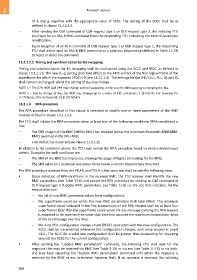Page 976 - 5G Basics - Core Network Aspects
P. 976
2 Transport aspects
of bi and gi together with the appropriate value of SCCC. The setting of the SCCC shall be as
defined in clause 13.2.1.1.5.
– After sending the OLR command of OLR request type 1 or OLR request type 2, the initiating FTU
shall wait for an SRA-R RMC command from the responding FTU, indicating the time of parameter
modification.
– Upon reception of an OLR command of OLR request type 1 or OLR request type 2, the responding
FTU shall either send an SRA-R RMC command or a valid eoc response (as defined in Table 11-19)
to reject or defer the command.
13.2.1.2.3 Timing and synchronization for bit swapping
Timing and synchronization for bit swapping shall be maintained using the SCCC and SFDC, as defined in
clause 13.2.1.1.5. The new bi, gi setting shall take effect at the RMC symbol of the first logical frame of the
superframe for which the expected SFDC is 0 (see 13.2.1.1.5). The settings for the DTU (KFEC, RFEC, Q) and BD
shall remain unchanged, whilst the setting of BDR may change.
NOTE 1 – The ETR, NDR and DPR may change with bit swapping, in the case the bitswapping is changing the BDR.
NOTE 2 – Due to change of BDR, the NDR may change up to a value of 512 subcarriers x 12 bits/TF. For example for
TF=750µsec, this corresponds to 8.192 Mbit/s.
13.2.1.3 RPA procedure
The RPA procedure described in this clause is intended to modify one or more parameters of the RMC
channel defined in clause 13.2.1.3.2.
The FTU shall initiate the RPA procedure when at least one of the following conditions (RPA-conditions) is
met:
– The SNR margin of the RMC (SNRM-RMC) has dropped below the minimum threshold (MINSNRM-
RMC) specified in the DPU-MIB;
– a lor defect has occurred (see clause 11.3.1.3);
In addition to the conditions above, the FTU may initiate the RPA procedure based on vendor-discretionary
criteria. Examples for such conditions are:
– The SNR of the RMC has improved, allowing the usage of higher bit-loading for the RMC;
– The SNR value on a particular subcarrier drops below a vendor discretionary threshold.
The RPA procedure initiated from the FTU-O and FTU-R is the same and shall include the following steps.
• Upon detection of RPA-conditions in the received RMC, the FTU receiver shall identify the new
RMC parameters (see Table 13-6) and initiate the RPA procedure by sending an OLR command of
OLR request type 4 (Update RMC parameters, see Table 11-9) via the eoc that indicates, for the
receive direction:
– the list of new RMC parameter values (new configuration);
– the superframe count on which the new RMC parameters shall take effect. The minimum
superframe count indicated in the first transmission of the RPA request shall be at least four
superframes later than the superframe count when the eoc message carrying the RPA request
is expected to be received (the value shall take into account the maximum transmission delay
of the eoc message over the line);
– the 4-bit RPA configuration change count (RCCC) associated with the new configuration. The
RCCC shall be incremented whenever the configuration changes, with wrap around at count
11112 The RCCC for a valid new configuration shall be greater than (accounting for wrapping
around) the RCCC for the current configuration.
• After sending the "Update RMC parameters" command, the initiating FTU shall wait for the
response that may be received via RMC (see Table 9-16) or via eoc (see Table 11-19) or via both,
and may keep repeating the "Update RMC parameters" command until either the response is
received via the RMC or eoc (whichever happens first). If no response is received, the initiating
966

